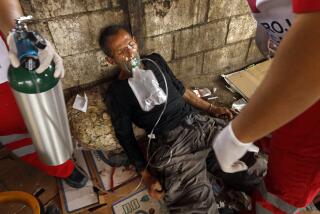Carbon Monoxide, the Silent Killer
- Share via
Carbon monoxide is a silent killer. It sneaks up on its victims, odorless and colorless. It makes people drowsy and puts them to sleep.
Last year, according to an EPA study, 1,500 people nationwide died of carbon monoxide poisoning, another 10,000 were poisoned but lived.
Often, as was apparently the case in Tijuana where authorities believe 12 people died from asphyxiation and six others were injured from a butane-burning lantern, the lack of simple air circulation, through a vent or open window is the main factor that allows the deadly gas to accumulate.
Dr. Anthony Manoguerra, director of the Regional Poison Control Center at UC San Diego Medical Center, said that, although the Mexican deaths have the appearance of carbon monoxide poisoning, only laboratory blood tests can confirm it.
Mexican officials are relying on the San Diego County medical examiner’s office to conduct those tests.
Manoguerra said symptoms of carbon monoxide poisoning are headaches, nausea and possibly vomiting. Often, he said, people don’t recognize the symptoms for what they are and associate them with some other malady.
“They think there’s some other reason they aren’t feeling well,” he said. “Often they don’t put the symptoms together.
“You can drift into (sleep) before you realize what is happening.”
For those who survive, their prospects of good health depend on factors such as how long they were exposed. The medical center, for example, has a hyperbaric chamber it uses to treat people poisoned by the gas. By raising the air pressure, the chamber increases the amount of oxygen in the body tissues, removing the carbon monoxide from the blood more quickly.
In Tijuana, where there is no hyperbaric chamber, officials are administering oxygen to the six survivors who were poisoned. Manoguerra said this works but usually takes longer.
Manoguerra said that, depending on the severity of the poisoning, it is not unusual for people to suffer permanent nervous system or brain damage.
Manoguerra said carbon monoxide is usually a byproduct of any system that burns natural gas, such as butane or propane, in the presence of oxygen. If everything is working properly, the system will produce carbon dioxide--the harmless gas that is expelled when people exhale.
However, if the system is receiving inadequate amounts of air or is faulty internally, it instead spews out deadly carbon monoxide, he said.
More to Read
Sign up for Essential California
The most important California stories and recommendations in your inbox every morning.
You may occasionally receive promotional content from the Los Angeles Times.













